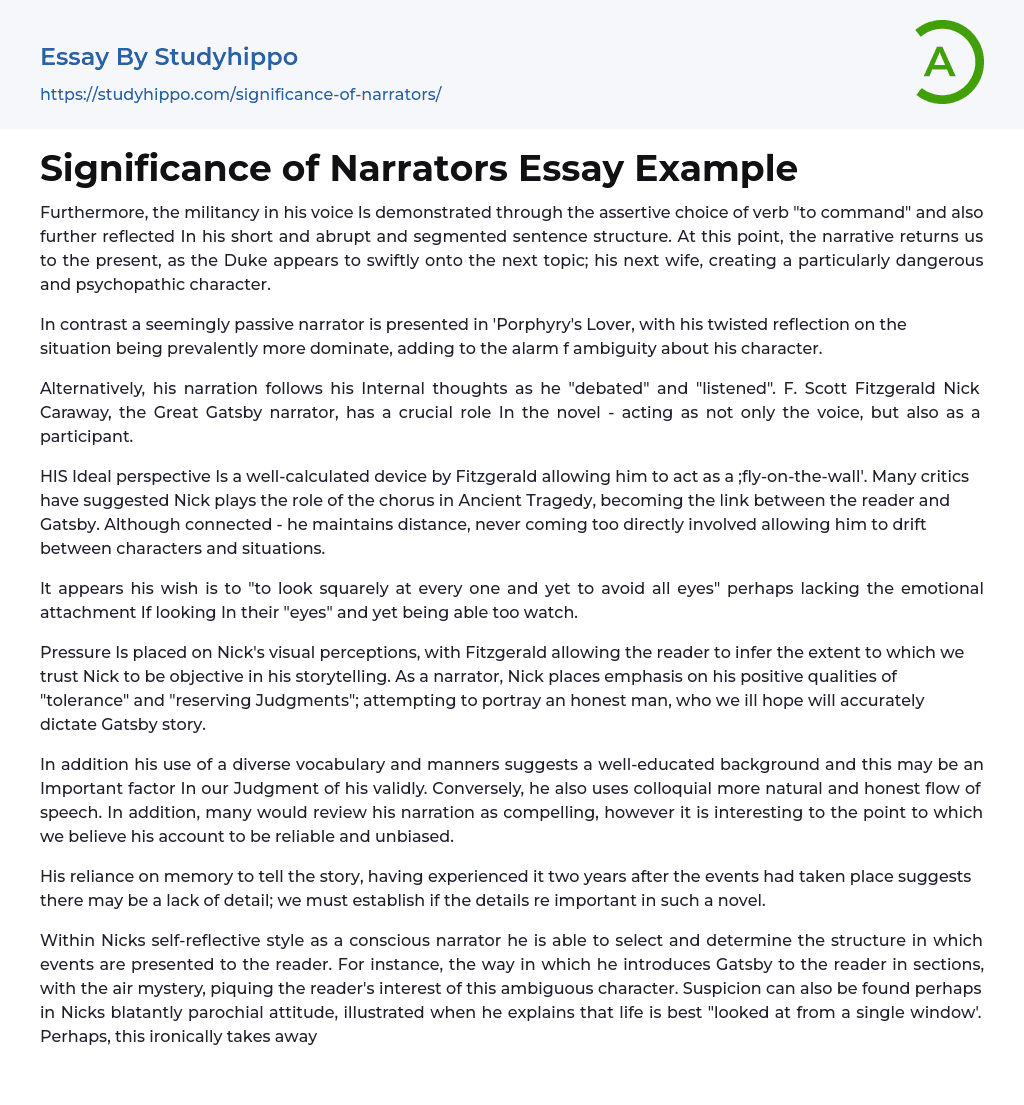In the first text, the author discusses two different characters' narration styles. The Duke in "Porphyry's Lover" exhibits strong assertiveness and a fragmented sentence structure that highlights his psychopathic nature when discussing his next wife. In contrast, the narrator in the same story takes a more passive approach, relying on internal thoughts to guide his storytelling. Meanwhile, in "The Great Gatsby," Fitzgerald uses Nick Carraway as both a participant and a narrator. Nick plays the role of an observer or fly-on-the-wall, allowing him to remain distanced from the characters and situations while still conveying them to the reader. Ultimately, Nick's desire is to avoid emotional attachment and remain objective.Fitzgerald's depiction of Nick's storytelling places pressure on Nick's visual perceptions and allows the reader to infer his ability to be objective. Nick emphasizes his positive
...qualities of "tolerance" and "reserving judgments," portraying himself as an honest man capable of accurately dictating Gatsby's story. Nick's use of a diverse vocabulary suggests a well-educated background, but he also relies on colloquial speech, creating a more natural flow. The reliability and bias of Nick's account are questionable, given his reliance on memory and lack of detail. As a conscious narrator, Nick determines the structure of events presented to the reader, introducing Gatsby gradually with mystery and piquing the reader's interest. Nick's parochial attitude also raises suspicion, as he suggests that life is best viewed from a single window.The impressive nature of Gatsby is called into question, as it seems he may be sacrificing accuracy for simplicity. This can be seen when Nick easily believes Gatsby's medal is real, raising questions of his naivety or willful ignorance to make th
story more exciting. Additionally, Fitzgerald's use of retrospective narration creates a restrained quality surrounding Gatsby's death. While Gatsby's life remains mysterious, Nick's observations provide social analysis, such as feeling disgusted after leaving a party. With objects imbued with symbolism, Nick's narration is crucial in presenting Fitzgerald's social and political messages. To create suspense, Means uses first-person narration through Joe Rose's interior monologue.
Joe relies on his scientific background to make sense of the tragic balloon incident, using scientific terms in his narrative to provide a reliable and coherent account for the reader. He retrospectively manipulates events during the incident to offer additional details, taking on an almost omniscient perspective. While this could be perceived as biased towards his own perspective, the reliability of his narration is put into question when he expresses doubt about his memory of an underwater event. Nevertheless, Joe's sequence of events remains a central motif in the book, as it builds up the significance of what is about to happen while maintaining ambiguity.
Joe Rose is a center of consciousness and the main focal point of the narrative form explored in post-modern novels. He utilizes a technique that is considered unattractive, as it distorts reality and gives only one person's perspective. In an article he is working on, Rose reflects on how narrative form can cloud judgment and negatively impact the structure of scientific knowledge.
The story also includes multiple perspectives, such as those of Jean Logan, who believes her husband is having an affair despite having no actual proof. The symbol of the rose is present throughout the text, raising questions about the reliability of the narrator and whether the reader can
trust them.
Rose's knowledge, self-knowledge, veracity, and self-delusion all come under scrutiny. He questions his own ability to tell a story accurately when he brings up Jed Parry, a character he himself is creating.
Symbolic patterns of lenses, water, and prisms are used to distort truth and create a blurring effect on reality. The Hubble telescope is a significant example of how science can correct lenses to better reflect reality. Each character in the novel views life through their own lens, leading to conflicts and misunderstandings.The novel portrays how science can correct distorted views and how reality can be altered even by stalking, as seen in Jed's lens. Each of the main characters has their own perspective on life: Joey's is scientific, Calamari's is artistic, and Jed's is distorted by his De Secularist's syndrome. Conflicts in the story arise due to these diverse psychological perspectives. Samuel Coleridge's ideas are reflected throughout the text.
- Nightclub essays
- Accident essays
- Awareness essays
- Benefits of Volunteering essays
- Challenges essays
- Childhood Memories essays
- Decision essays
- Driving essays
- Event essays
- Excellence essays
- Expectations essays
- Failure essays
- Farewell essays
- Flight essays
- Gift essays
- Growing Up essays
- Ignorance essays
- Improve essays
- Incident essays
- Knowledge essays
- Luck essays
- Memories essays
- Mistake essays
- Obstacles essays
- Overcoming Challenges essays
- Party essays
- Peace Corps essays
- Personal Experience essays
- Problems essays
- Sacrifices essays
- Struggle essays
- Success essays
- Trust essays
- Vacation essays
- Visit essays
- Volunteering essays
- John Locke essays
- 9/11 essays
- A Good Teacher essays
- A Healthy Diet essays
- A Modest Proposal essays
- A&P essays
- Academic Achievement essays
- Achievement essays
- Achieving goals essays
- Admission essays
- Advantages And Disadvantages Of Internet essays
- Alcoholic drinks essays
- Ammonia essays
- Analytical essays




